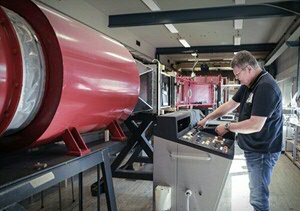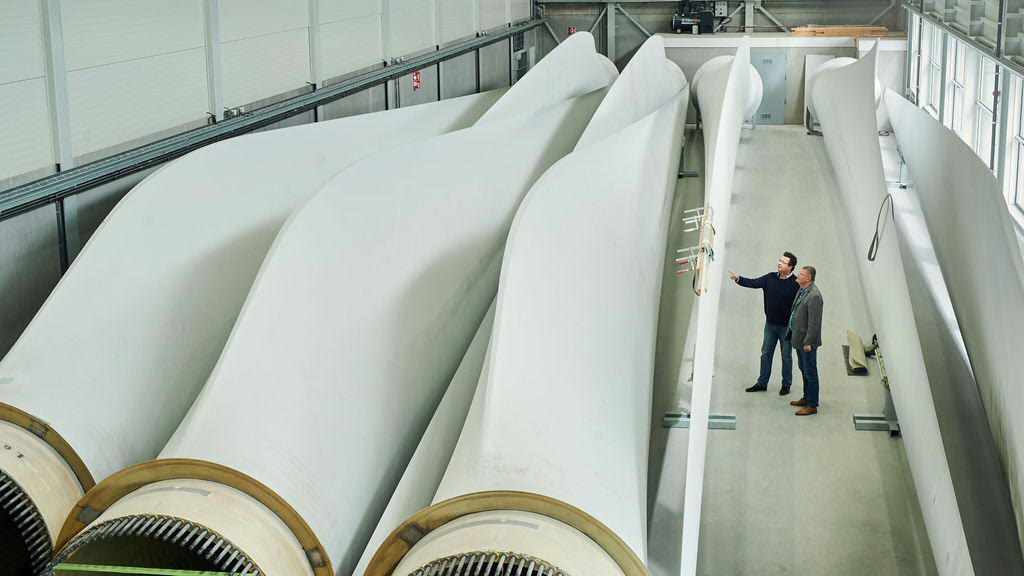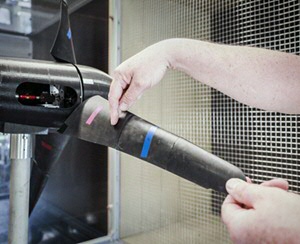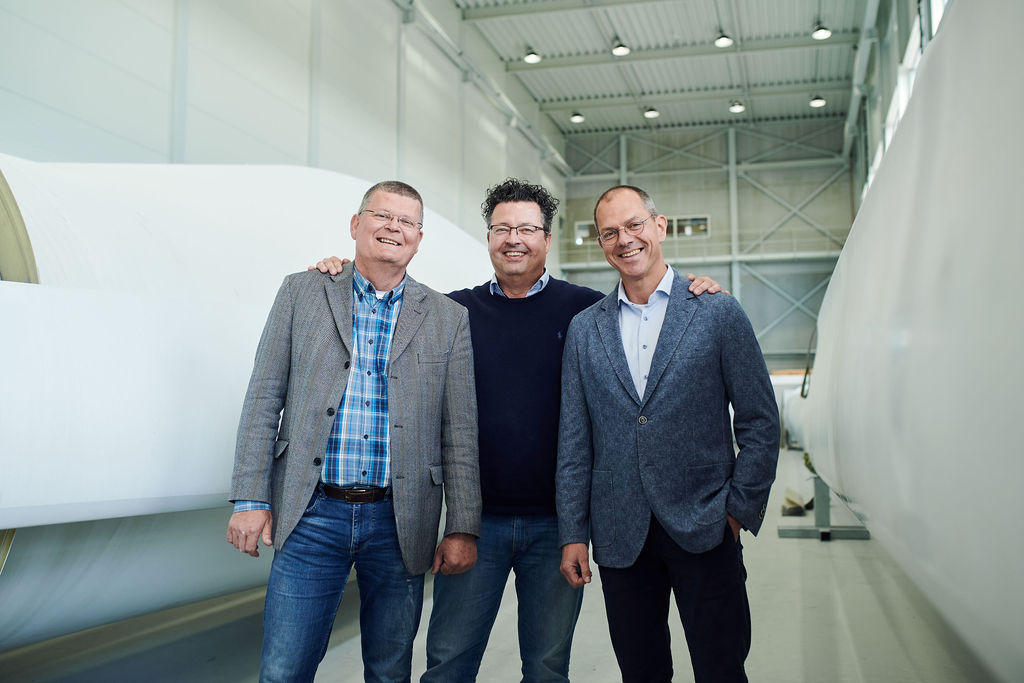Team Albatrozz builds revolutionary wind turbine after ‘Wallace & Gromit’ discovery by Stamhuis

In his wind tunnel at Zernike Campus, Eize Stamhuis discovered the smart power of sea birds. But what could he do with the patent for promising wind turbine blades? An alliance with two pioneering entrepreneurs led to the Albatrozz start-up. From looking through a pair of binoculars on Heligoland to developing a spectacular wind turbine at Zeewolde and large-scale applications.
Text: Riepko Buikema, Communication Office. Photos: Henk Veenstra, Douwe de Boer
‘Have you ever seen a video of an albatross landing?’, asks Eize Stamhuis. It is not the first time this afternoon that his eyes have twinkled behind his rimless glasses. ‘It looks more like a plane accident. Boom, crash.’
The sea birds, with their enormous wingspan, have a special technique to thank for their difficult landings. Albatrosses allow their long wings to ‘oscillate’: to wiggle around on the longitudinal axis so that they can still safely reach ground despite their low speed.
Heligoland
This wiggling technique intrigued Stamhuis. As an associate professor of Experimental Marine Zoology and Biomimetics, he is always on the lookout for applicable wonders of nature. His first port of call was to visit Heligoland, where he stood on the rocks with a pair of binoculars. ‘There, you can see giant petrels that continuously make exactly this motion while flying slowly. They play with air turbulence. It is incredibly interesting to watch this, to learn from nature. There is still a lot to be discovered around unstable aerodynamics. Engineers are often quite nervous about it, but I’m not. This is when it starts to get fun.’
Long story short: Stamhuis copied the movement of albatrosses, tested it with model wings in his wind tunnel at Zernike Campus, and was astonished by the results. ‘The lift, the upwards power of the wing, was twice as strong at peak moments due to wiggling like this.’ This was a great finding for an academic publication, but technician Stamhuis (he attended an institute of technology for a few years, and was a professor at a technical university of applied sciences in Germany for 10 years) was eager to find an application.

Extra yield
Wind turbines appeared to be the exact niche for the unexpected effects of wiggling albatross wings. ‘Wind turbines are reasonably inefficient at low wind speeds. They are designed for optimal yield with speeds above eight or ten metres per second. But this hardly ever occurs in the Netherlands. Even at sea, the wind speed only averages six or seven metres per second. By allowing part of the blade to wiggle, a turbine can start rotating sooner and you can obtain extra yield precisely in low wind speeds.’
‘This idea was already born eight to ten years ago’, says Stamhuis, immediately reaching for a scale model of a turbine blade as soon as he enters his office. Here, in the organized chaos of boxes containing Lego aeroplanes, cardboard wings, and plastic fish, he enthusiastically demonstrates his finding. ‘We keep changing the aerodynamics briefly by allowing parts of the blade to move independently of one another, just like the wiggling of the albatross wings. In low wind speeds, this produces 25% to 35% more wind energy.’

A patent was then developed with the approval of the Board of the University. ‘But then we actually needed to do something with it’, sighs Stamhuis. ‘Such a hassle! If you want to enjoy watching air streams move around a wing in a wind tunnel, then I will be there. But market research... that is just not my thing.’
Suspenseful
On the initiative of the Stichting Business Generator Groningen (SBGG) foundation, Elzo de Lange entered the stage. His business EmpowerMi helps large companies with valorization and innovation and assists research groups in taking their findings a step further. ‘In the past, I worked closely with the business owned by my companion Geert van de Ek on the financing and building of Gemini, which was then the largest Dutch wind farm at sea. We asked ourselves the question: could the wind sector do something with this finding, and would it dare? The deliberation was very suspenseful. There was a potentially valuable patent that was soon due to expire, while the application was far from ready to bring to the market. Geert and I looked one another deep in the eyes: were we going to let it go, or to fire it up and try it in any case?’
They chose the latter. De Lange: ‘Thanks to our business network and our inroads at the right level with large turbine builders and wind farm operators, we were able to produce an analysis at lightning speed.’ This led to the Albatrozz start-up, which, supported by the Dutch Research Council (NWO) and later by the Ministry of Economic Affairs and Climate, was founded with just one aim: to convince even the greatest sceptics that this revolutionary idea, Stamhuis’ original finding, was profitable, safe, and achievable.
Shocked
These sceptics were in abundance, as Stamhuis found at the WindDays 2019 network gathering in Rotterdam. ‘We were the new kids on the block, the “Wallace and Gromit” who had come up with another wacky idea.’ And that is putting it mildly, admits De Lange. ‘At first, everyone in the sector was shocked. The development in this sector had been completely focused on the opposite direction for years: towards larger, stable turbines, built in areas with even stronger winds. But we were precisely focusing on smarter, more complex, and dynamic turbines. This made it very risky. The market first made us do the heavy lifting ourselves.’

Hard work won’t get you anywhere without a bit of luck, laughs De Lange. Wind producers are increasingly suffering from global terrestrial stilling, the phenomenon caused by climate change that has caused the average global wind speed to decrease over the past three to four decades. ‘This is now reflected in their annual figures. As a result, the focus is shifting towards yield in low wind speeds. In addition, due to grid congestion during peak moments, it would be hugely interesting if we could produce wind energy at moments when others are only able to produce small amounts, or none at all.’
Destruction
This realization gave the Albatrozz guys extra wind in their sails on the route to Barneveld, the Dutch wind energy valley, where countless businesses have sprouted up around the famous Lagerwey wind turbine manufacturer. In a hangar owned by Rengineers, a set of three existing blades were adjusted by experts from the wind sector based on Stamhuis’ findings. ‘A few weeks ago, we sawed the first piece out of one of those blades’, says the researcher. ‘It felt really odd, as we were actually destroying something very grand. But this somewhat elastic, 26-metre-long blade, with four two-metre-long flaps that can wiggle, is actually the brainchild of Albatrozz.’
Soon, the blade will actually have to be tested: in a pasture near Zeewolde, a Pure Energie turbine will be fitted out with Albatrozz blades. ‘We will soon be able to make comparisons with an identical turbine, which has not been modified, two-hundred metres further along and with the historical data of all wind turbines in the park’, says De Lange. ‘We will look at the yield, noise, reliability, and wear and tear. It is up to us to provide the ultimate proof that our technology works.’

Optimism
The entrepreneur is hopeful. ‘Market interest is becoming more concrete. A select group of wind park owners and turbine builders recently joined a discussion with us on our progress over the past two years and the current design. Albatrozz is starting to pick up feedback.’
And Stamhuis? He is already on the hunt for new findings. Together with a PhD student, he built a small wind turbine on his farm just outside the city. The blades are based on the helicopter seeds of the maple tree. ‘The blades are very simple, with a slightly lower yield, but are much easier to fabricate than regular ones. They are no more than a plank of wood with an edge, which could be ideal for developing countries.’ He laughs. ‘I look at the world differently now—I see air streams everywhere.’
More news
-
17 December 2025
Ben Feringa wins Feynman Prize
-
11 December 2025
Stormy planets and an unexpected atmosphere
